Lion photography tips
Lion photography tips
How to photograph an African Lion on safari
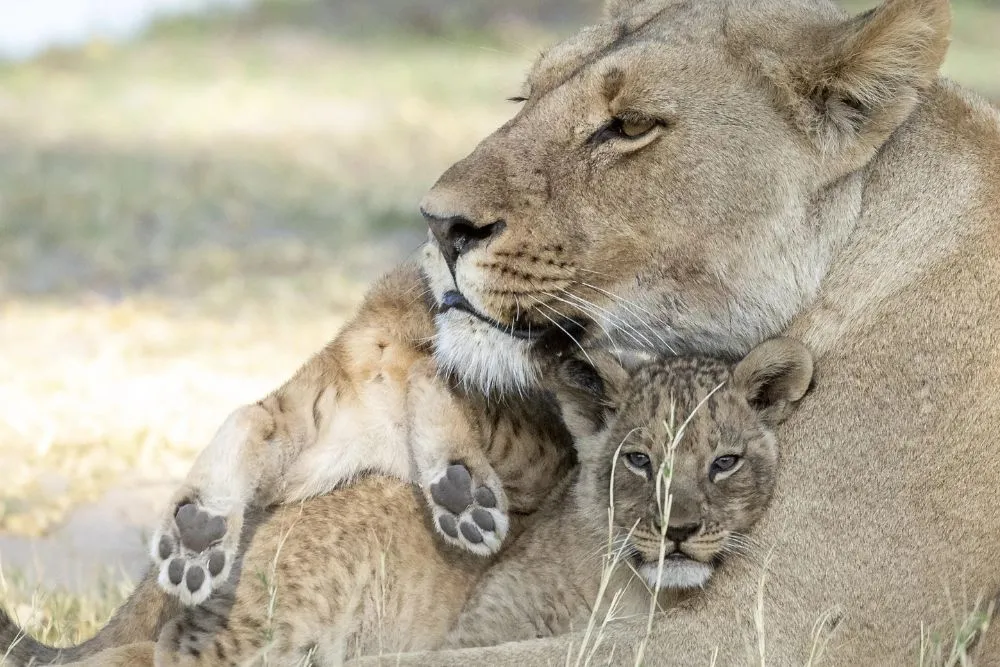
A lioness embraces a cub. © Janine Krayer
When you come to Africa there are no more iconic species to photograph than African Lions. In this blog, Janine will explain how to photograph the very essence of the king of the jungle!
How to photograph lions with Pangolin Photo Host Janine Krayer
Many safari “fundi’s” and photographers say that watching lions is one of the most boring wildlife sightings. The reason being is that lions like to sleep for most of the day…actually between 16 and 20 hours per day, to be exact. As a comparison, that is the same amount of time elephants are active daily, providing you with little to see in many scenarios.
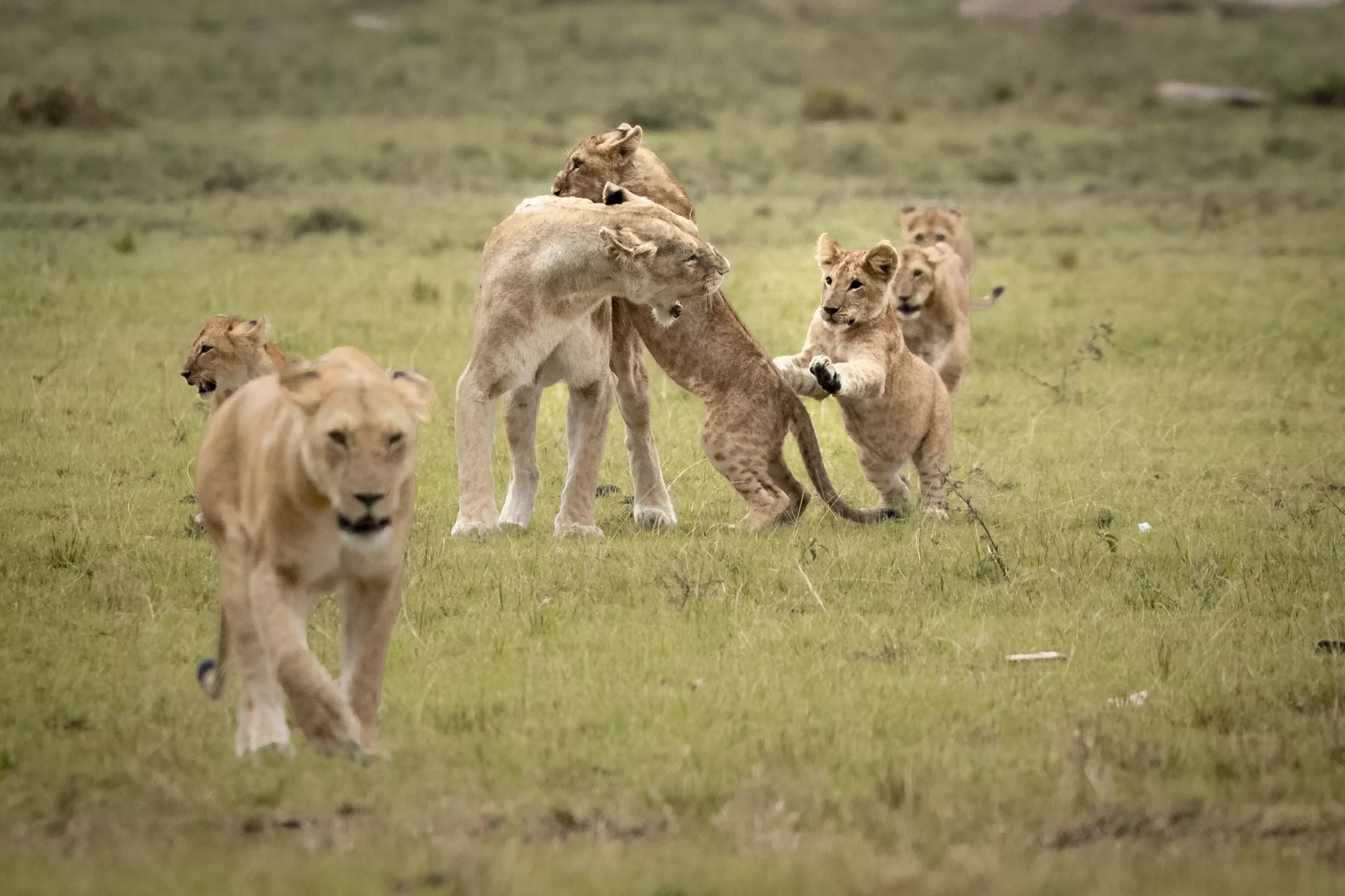
Cubs enjoying a play with the lionesses. © Janine Krayer
Janine has spent a decade watching and taking photographs of these majestic cats prowling the African Bush and has come up with a list as to why she loves taking lion photos.
Social Behaviour of African Lions
Lions, are the largest African cat, and believe it or not, are the only truly social cat. They live and hunt in groups called pride. Each pride will consist of several lioness and their young that are somewhat related. This pride is protected by one male lion or sometimes even a brotherhood of male lion called a coalition.
So yes, while lions tend to sleep a lot, just like your cat back at home, their active social life allows you for frequent interaction, ranging from endearing to fierce. What a collection of photographs you can get from spending time with these cats.
Iconic and almost always beautiful lion photos are the brief moment when lions greet each other by rubbing their heads together, tenderly and playfully pouncing onto each other. This happens nearly every time they approach a family member, therefore giving you good chances.
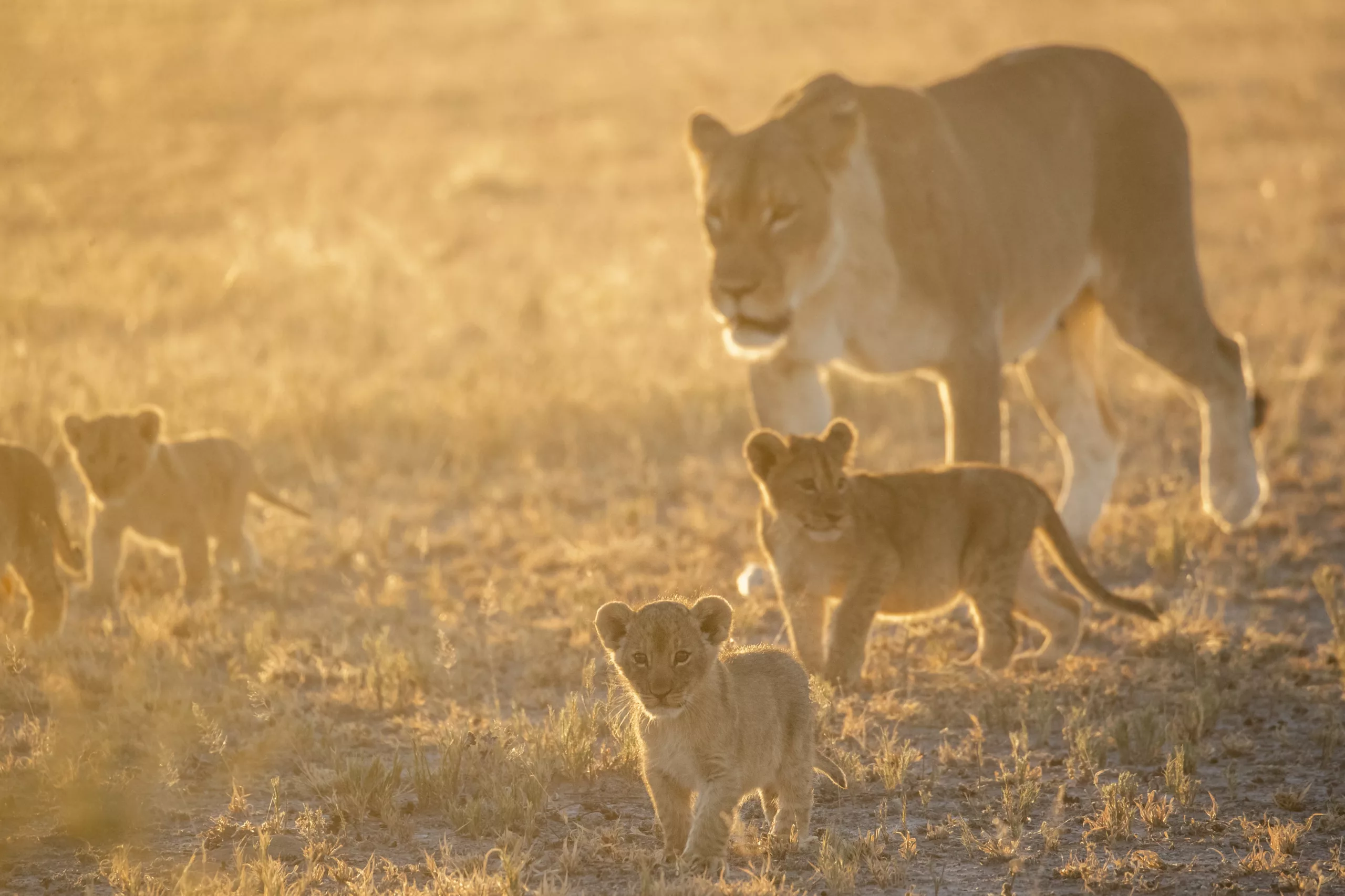
Golden light with a lioness and cubs. © Janine Krayer
Tip: These scenarios often demand a smaller aperture (F8 – F10) as you would like multiple lions to be in focus. You also want to be ready for any unsuspecting mock charge so keep your shutter speed at a minimum of 1/2000.
Given that both female and male lion are most active in the early morning hours, and at dusk, these requirements can be challenging to meet, as low light conditions might drive your ISO far beyond your comfort level.
So, what to do? In this situation, the first thing Janine will do is lower her f-number as low as possible. Although by doing this you decrease your depth of field so make sure you are focused on the main subject of your frame.
Of course, this is also subject to what the lions are doing. If you know for a fact that the lions are stationary, you might switch your priorities for the photograph.
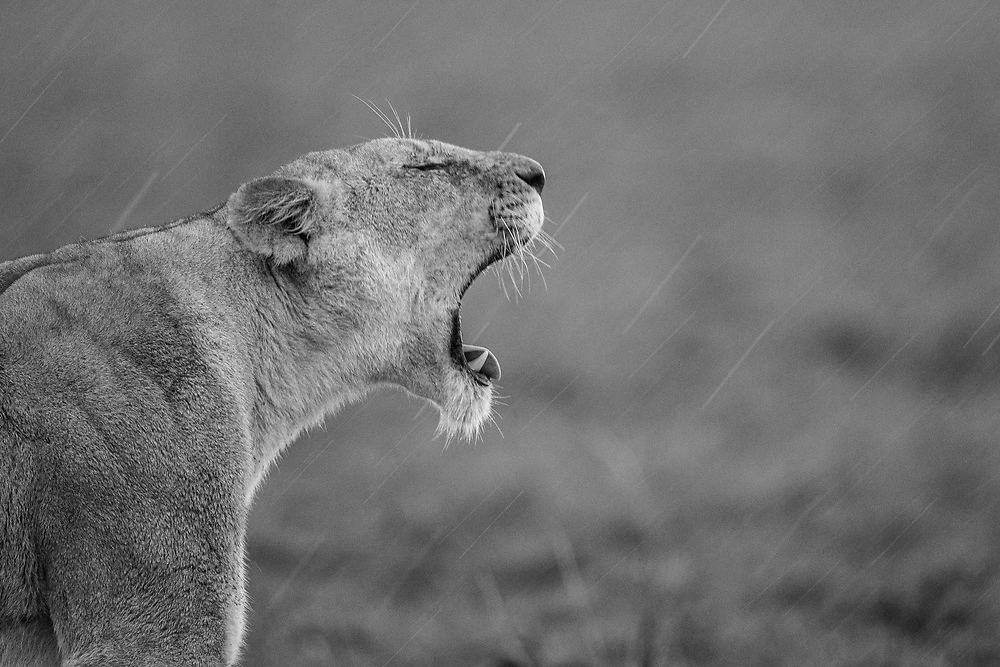
Masai Mara lion calling in the rain. © Charl Stols
Editing tip: Slightly grainy high ISO images often look great in black and white as they tend to lose colour contrast.
Capturing playful cubs in the moment
Compared to other solitary cats, lions also have an advantage in numbers when raising their young. Lioness often get pregnant in close succession to each other and care together for the nursery. Going as far as babysitting for nieces and nephews when mum goes to look for water or food.
While we can all agree that there is hardly anything cuter than playful lion cubs it is incredible how these big predators can be so caring and affectionate. Capturing their unwavering patience is also something unique on its own.
These precious interactions can also be hard to come by as the lionesses will often keep the lion cubs safe and hidden away for the first few weeks of their lives. Therefore, photographers are often confronted with high grass and bushy leaves, not giving you much chance for a clear shot and smooth background. For these scenes, a large aperture prime lens will come in handy as an F 2.8 lens can calm down a busy environment.
While we have spoken about the caring, affectionate and tender moments between a pride, we cannot forget that we are still talking about one of the most powerful predators roaming the land. Bring us to the next topic:
The power of the African male Lion
The sheer power of the lion is nothing short of inspiring. Shifting 200 kilograms at a top speed of 80 kilometres per hour and equipped with razor-sharp teeth that have a bite force of more than double that of a grizzly bear – you can say that these predators are a force to be reckoned with.
There is something beautiful about this strength, and when you get the chance to catch them in action – it can leave you with goosebumps. Over time, a lion’s roar has become synonymous with the African lion…and with good reason. There is nothing that makes you feel more like you are in the bush than to hear this echoing call across the horizon.
Being able to capture them roaring with their chin slightly elevated, and their lips parted, is an iconic photograph of a lion. On cold winter mornings, you might even be able to see the mist coming out of their mouth against the orange colours of the rising sun.
Tip: The lower your angle, the better you can display the size and power as it gives you a head-on perspective. A realistic idea of how we would perceive the size of the lion when faced head-on. This can easiest be achieved when the lion is elevated on a mound or a ridge also giving you the iconic image of the King overlooking his territory. Alternatively, you can get a chance of photographing a low-angle lion, safely from an underground hide.
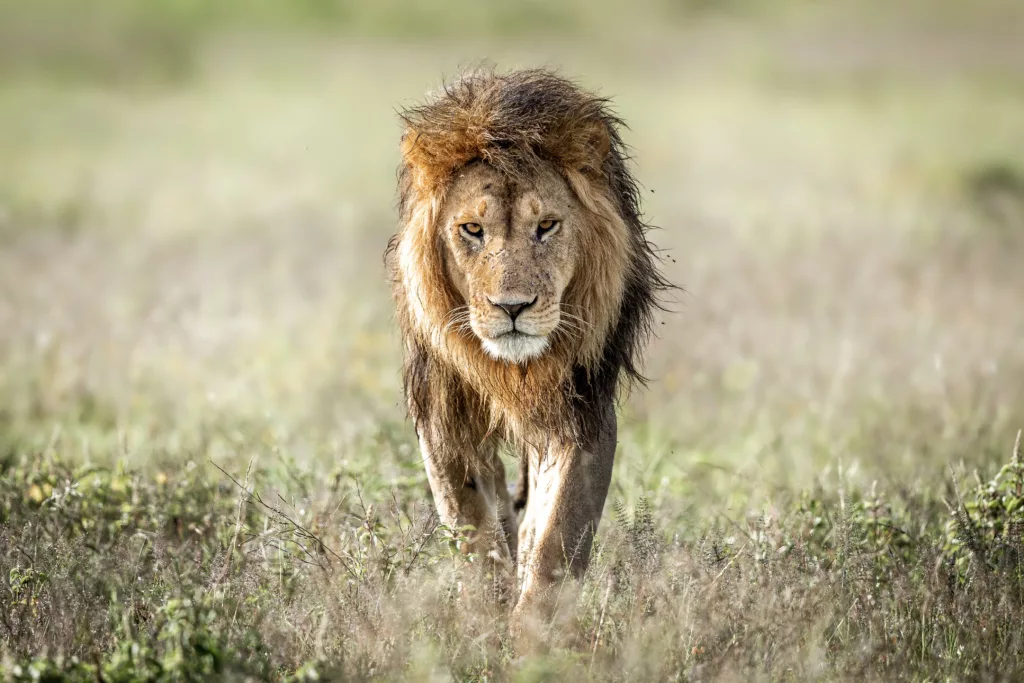
A striking male lion walks toward the camera. © Charl & Sabine Stols
Most animals don’t take kindly to a lion being in their presence so therefore any type of lion-wildlife interaction will for sure end providing you with an action-packed experience. So you want to keep your shutter speed fast ( >1/2000).
Capturing the eyes in Lion photos
A portrait of a lion is often the most mesmerizing as its yellow eyes can send shivers down your spine. These are often the lion photos of your dreams! A lion is a well camouflaged, tawny-coloured cat with its eyes accentuated by black lines and white fur to make them stand out.
As previously mentioned, lions are sleepy creatures. Meaning that their eyes are often closed or aloofly opened. Another problem is that when the sun stands higher, the lions’ eyelashes tend to throw a diagonal shadow straight across the eye, disturbing the portrait. Or, when the sun sets, lions simply do not enjoy looking straight into the sun as a blind spot. So how should you go about getting the shot?
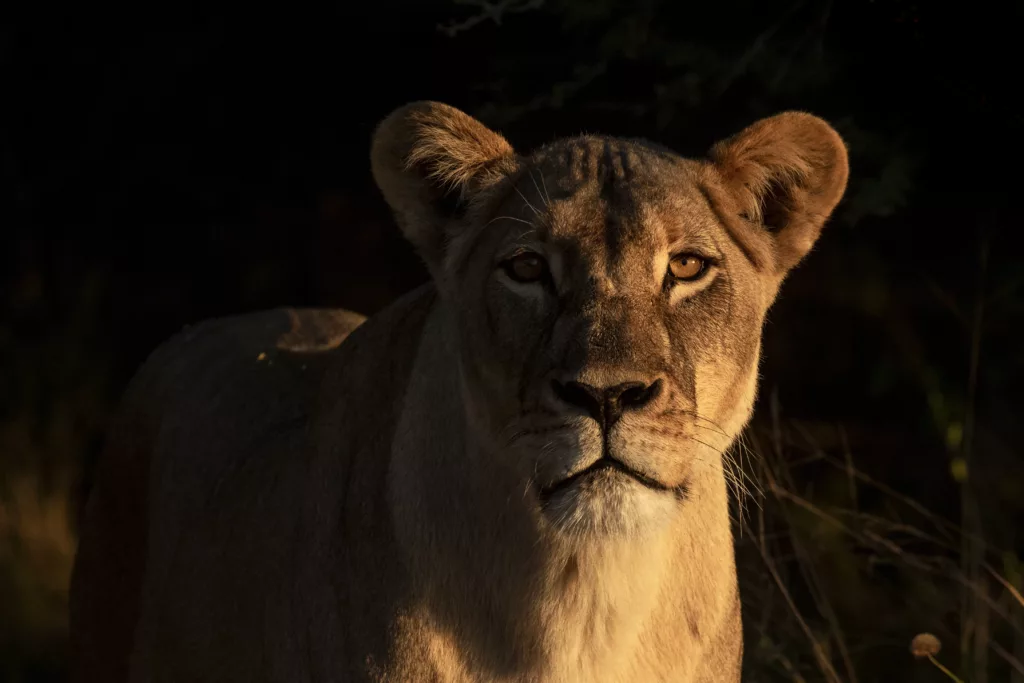
Evening glow on a lioness. © Janine Krayer
You will need to get up early or stay out as late as park rules allow and hope that the lion will briefly turn its head into the low-standing sun to provide intense glowing colour. The more the lion is elevated, the easier it will be for you to avoid any shadow. Another option is to shoot on an overcast day, which solves the problem entirely, as you will get a beautiful depth and detail in their eyes.
Photography tip: Try capturing the moment they look into the sky or have their chins lifted. These can create dreamy images with loads of emotions. Look out for particularly insistent flies, or birds doing an alarm call above the lion’s head. Sometimes you can also snatch these moments when the lion is looking for a piece of wood to stretch or scratch its claws on. They could also look at you as they pass the game viewer! Whatever the cause, the pose won’t last long and will have to be photographed quickly.
To create a gorgeous portrait shot, try using wide-open apertures to create a sharp focus on the eyes (<F5.6) with the rest of the face slowly blurring out towards the nose and the ears. Make sure your single point autofocus will sit right on the eye though as a cluster focus often catches the wrong spot. Before moving on, we of course have to mention the iconic yawn. This moment is every photographers dream shot of the king of the jungle.
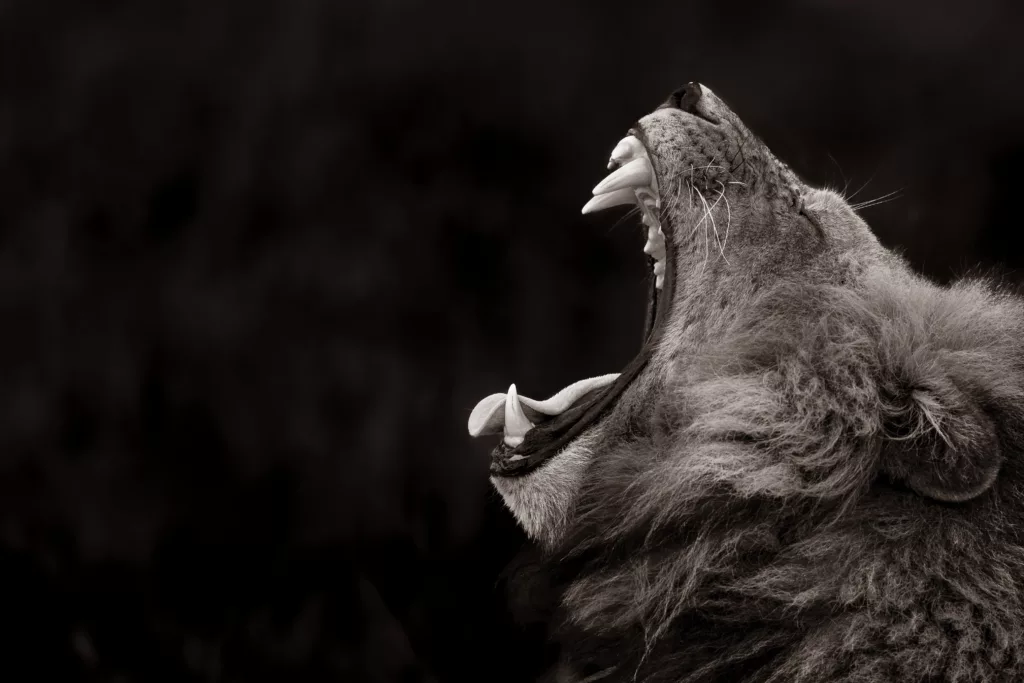
Male lion yawning. © Charl Stols
Timing a yawn is quite easy, as it tends to come alongside them starting to lick and clean themselves and the more they lick their lips, the more likely they will start yawning as well.
Photographing Lion on the hunt
Every wildlife photography enthusiast would love to have that exhilarating photo story of a hunt or a stalk so let’s dive into photographing this! Most hunts don’t end up in a kill, as only 30% of actual hunts are successful for these predators.
Although watching lion calculate their hunt is exciting, it remains quite difficult to photograph. How do you remove the “gore” from a good photograph?
Let’s explore Janine’s guidelines:
- Try and photograph the actual sprint, or leap by the lion while the chase is ongoing.
This type of photography is very dependent on its background though, as you have to zoom out sufficiently to photograph the entire scene. Long grass and bushes can make this very difficult.
- Photograph the kill from the side of the animal where the skin is still intact.
Usually, they try to reach their meal through the softest part of the body, which is usually the belly. Photographing the kill from the back and waiting for the lion to look over it can be a great shot while avoiding the gory detail. From a photographic perspective, it looks good to have striking furs, such as a zebra or a giraffe.
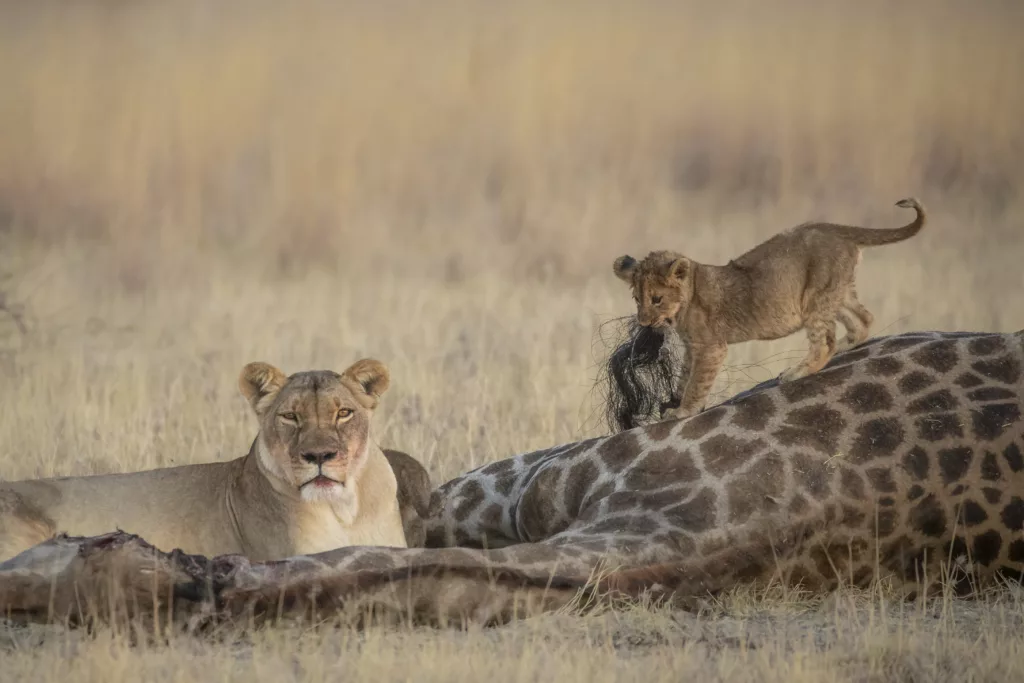
Lioness and cub at giraffe kill. © Janine Krayer
The art of the hunt
General tip: Utilize low-standing sunlight and shoot into the sun creating a golden atmosphere.
Close-up portraits of a red face – not showing the prey – compartmentalizes the scene and can look quite intense. As the feeding progresses the skeleton of the prey tends to offer amazing frames for the lion’s eyes and face.
When watching a pride kill or eat, focus on the unavoidable interaction between the lions. Fighting out pecking orders, growling, or playing while waiting for their turn provides you with great chances of telling a story. If the pride has lion cubs, they often get introduced to the meat as early as two months old. While they don’t know how to feed properly yet, they love to play around with the carcass and fight with each other for bits and bobs.

Sub adult lion rests during a feed. © Janine Krayer
Elephants, who often die of natural causes during the dry season offer a particularly great playground for cubs to play on while the adults are feeding.
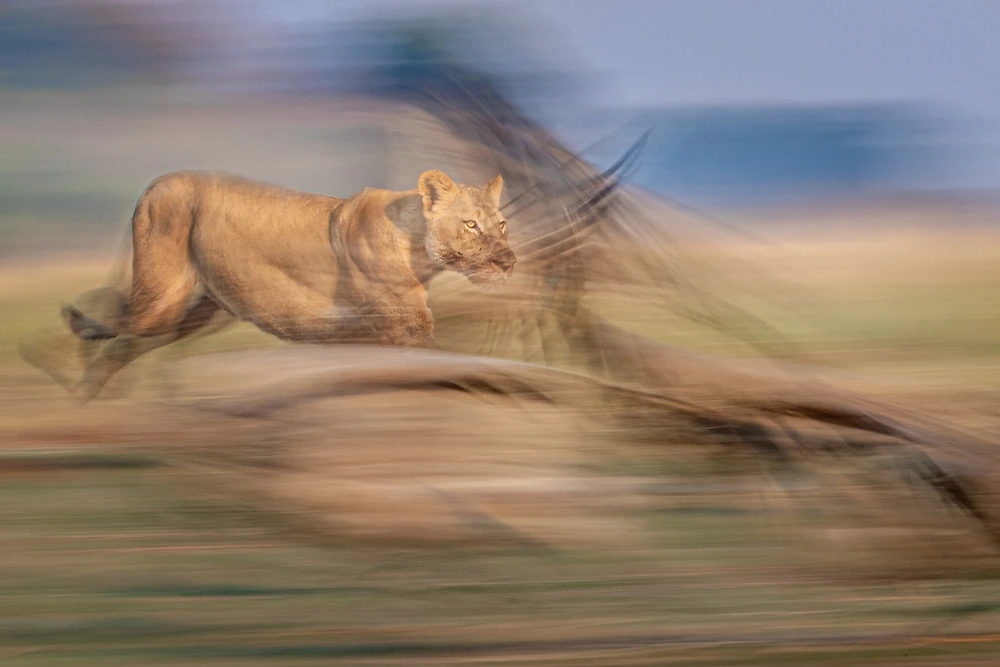
Slow shutter speed of a lion and vulture. © Sabine Stols
Pro tip: look out for cross-species interaction. Any larger kill is bound to attract scavengers that compete with them for the food source. With a bit of patience from your side, the feeding site will eventually change as the pride become less interested and their tummies full up. Pride and dominance don’t allow them to give up on their prey entirely though often creating a tug of war with jackals, vultures and sometimes even hyenas that are attracted by the smell.
Lions and water
Unlike tigers, these cats dislike getting wet, making it a rare and very special occasion to witness. It often becomes comical to watch them, when they’re forced to cross a stream, swim or even feed in the water as it’s an unusual sight to watch one of the biggest predators on land, hesitating and throwing a hissy fit.
Initial hesitation often gets replaced by frequent hissing and water slapping to ensure that the crocodiles know that they’re up against a worthy opponent keeping them at an arm’s length.
Your best chance for seeing them swim or do a water-crossing in Africa is definitely in the Okavango Delta where prides are often forced to cross streams of water to access their entire territory.
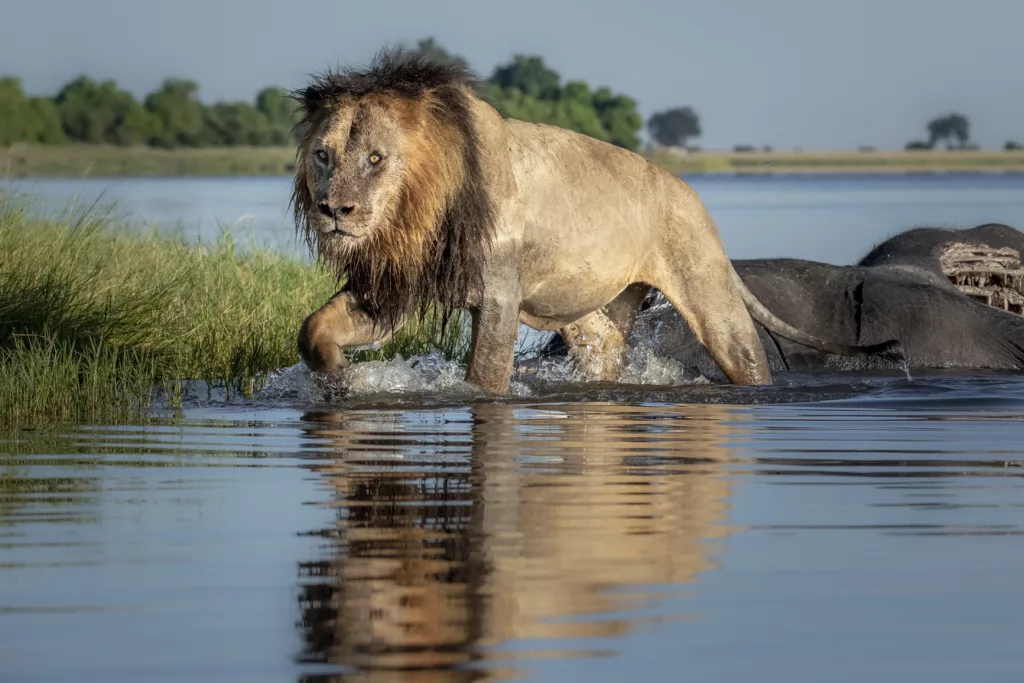
Male lion exits the Chobe River after a meal. © Janine Krayer
As water is usually reflecting the sky, and representing a very strong light source, you might find yourself wanting to overexpose the lion to make sure you see all the details unless you work with spot metering, of course. Even if you do not get the chance of watching a lion swim, simply watching them drink is generally an amazing chance for great photographs. If, and there’s always an if, there is no grass in front of them blocking their noses.
Once again, you want to be on eye level when taking that shot, and capture the moment when they just lift their head, glance up or have water droplets running down their chin.
The more that come to drink, the better. However, the luckier you need to get as everything needs to line up perfectly. So their heads, faces, ears and tails, are not overlapping awkwardly.
Tip: For multiple and single lion shots, Janine would recommend a slightly smaller aperture to ensure that the snout, tongue and water droplets are as sharp as the eyes(for example, F7.1 – F8). This is another reason why a low-angle shot would be preferable, as it will then still allow for a nice, smooth background.
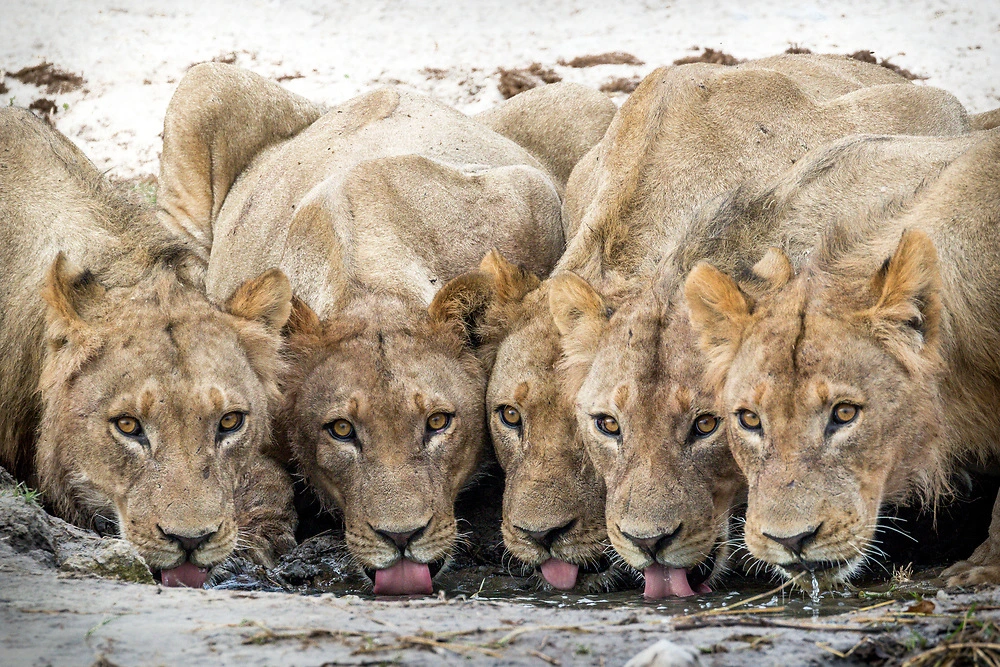
Pride of lions enjoying a drink. © Charl Stols
Be patient with getting wildlife photographs
As you can see, photographing these predators can be very multifaceted thanks to their social interaction. In time, knowing your subject, watching them and understanding their behaviour will help you capture gorgeous images.
From Janine’s perspective, even if a picture does not turn out to be ideal, to her, the process of taking it and waiting for the perfect shot while watching nature unfold, is the most satisfying and beautiful thing to do. That is when animals become real, as you start relating to their behaviour, and understanding their choices. An apex predator, like a lion that is often portrayed as savage, becomes worthy to protect, as you can see their place on this planet.
Conservation and wildlife photographs
Lions are listed as vulnerable as their numbers and natural habitat continue to plummet. In many places in Africa, human-wildlife conflict is a real issue for farmers and cattle herders, but creating an understanding and sharing the space with wildlife is the first step to acceptance.
Photographic tourism creates an international interest and brings money to protected areas, which in turn limits poaching and is a sure way of supporting endangered animals. While watching a growing number of cars around a pride of lion can be cringe-worthy one must understand that it is these tourists that provide indirect protection by ensuring that their natural habitats will remain intact. So next time you’re in the Masai mara, try not to worry about the other cars and just enjoy taking your photographs.
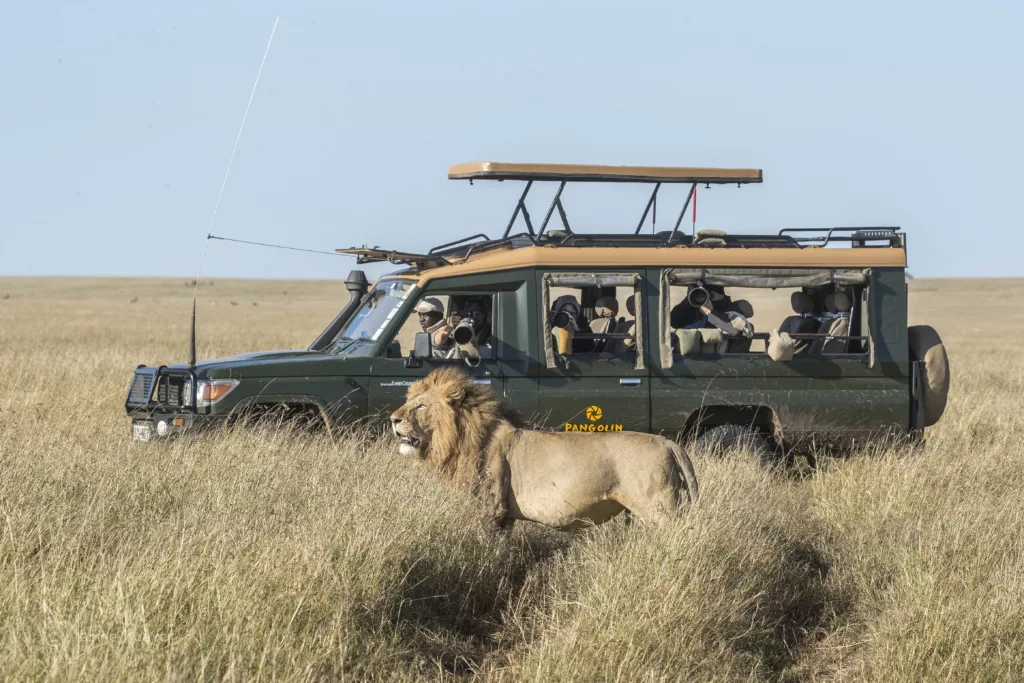
Pangolin Photo Safaris in Masai Mara, Kenya. © Janine Krayer
Game viewers are almost completely ignored by most prides as it’s something they have grown up with. To them, it is simply perceived as another piece of the landscape that happens to move sometimes. They continue as if we were not there. So while tourists can often destroy a place, they happen to be the lifeline of wildlife in Africa.
If it is your dream to come and enjoy the African game yourself one day, check out our exclusive deals. Book a free call with our travel consultants to discuss your trip to the Masai Mara, Chobe, Kalahari or Delta! In the meantime, check out our photographer’s guide to Botswana in our new e-book.
Time to put these tips to the test on your next safari!
Great Migration Photo Safari
The Great Migration Photo Safari in Kenya’s Masai Mara really needs no further introduction but certainly needs to be seen at least once in the lifetime of every photographer and wildlife enthusiast. We bring in our own vehicles and expert guides and include a hot air balloon trip on every safari. Hosted by the Pangolin hosts Guts, Janine, Danielle, William, Charl & Sabine as well as our Mara specialist Andreas Knausenberger this photo safari is always a photo highlight of the year for all involved!

Leave A Comment
You must be logged in to post a comment.